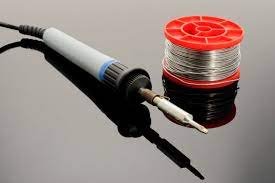Last Updated on March 22, 2024 by Aiman Emaan

An electric tin soldering iron is a hand-held electric tool, used for soldering accessories. Its function is to transform electrical energy into heat, causing the fusion of tin. Tin is the material used in the welding process, to act as a union.
If what you are looking for is a complete soldering station, I have also written an article explaining its characteristics.
The soldering iron is a basic tool in electronics. It allows the assembly or repair of circuits with their components, assembly of electronic components and equipment wiring.
It consists of a metal tip with an insulated handle. Tip heating is accomplished electrically by passing current through a heating resistor.
Table of Contents
Soldering with tin
Types of tin soldering irons:
There are a diverse variety of welders on the market. According to the current there are several: the normal ones that are fed directly from 220V through a transformer. There are also 12V ones. For example, to connect to the car’s cigarette lighter socket and make emergency repairs.
Resistance welder:
The most utilized. It has a fine copper tip and is heated with an electrical resistance that keeps it at a fixed temperature. They are generally shaped like a rod, hammer, or tip, depending on the use that is going to be given. It is useful for carrying out work on plate supports. Due to its power, it is used to work with superficial or large components.
Instant soldering iron:
they have the typical shape of a pistol. By pressing the button, its tip heats up quickly, and just by releasing the tin solidifies. It is very useful for occasional jobs because it warms up instantly. Its use in electronics is not common because the tip is not fine or precise.
The tips of the tin soldering iron must be treated with an anti-corrosive treatment. This treatment prevents oxidation when exposed to the open air and at high temperatures.
It should be turned off if it is not used for a long time and cannot be cleaned with metal objects, sanded or filed.
The power of the equipment will depend on the heat required for welding, depending on the size of the area to be welded.
For example, soldering the terminal of a transistor to a circuit track requires very little heat.
On the other hand, to solder a 2.5mm cable to a large terminal, a large amount of heat must be applied to compensate for the thermal dissipation generated by the cable and the terminal.
The use of the bracket is important when welding. The support apart from holding the piece helps to avoid accidents, such as burns to people.
The holder will allow some of the heat to be expelled from the tip and will prevent it from overheating.
This support can have a damp sponge and use it to hot clean the tip of the soldering iron.
Tin soldering
In electronics, it is common to use in with a resin core to facilitate soldering. The guarantee of a good solder is that both the tin and the object to be soldered reach the right temperature.
The temperature is usually between 200 to 400 ºC. If you need to regulate the exact temperature, there are soldering irons with regulators or soldering stations.
Carrying out a good solder will depend, in addition to the soldering iron and tin, on a substance called solder paste or flux.
The solder paste facilitates the distribution of tin on the surfaces, avoiding the oxidation produced by high temperatures.
It is made from rosin and is contained in the cavities of the tin wire. Its proportion is around 2-2.5%.
Read more: Electronic Components Online: A Quick Guide On How To Source?



























